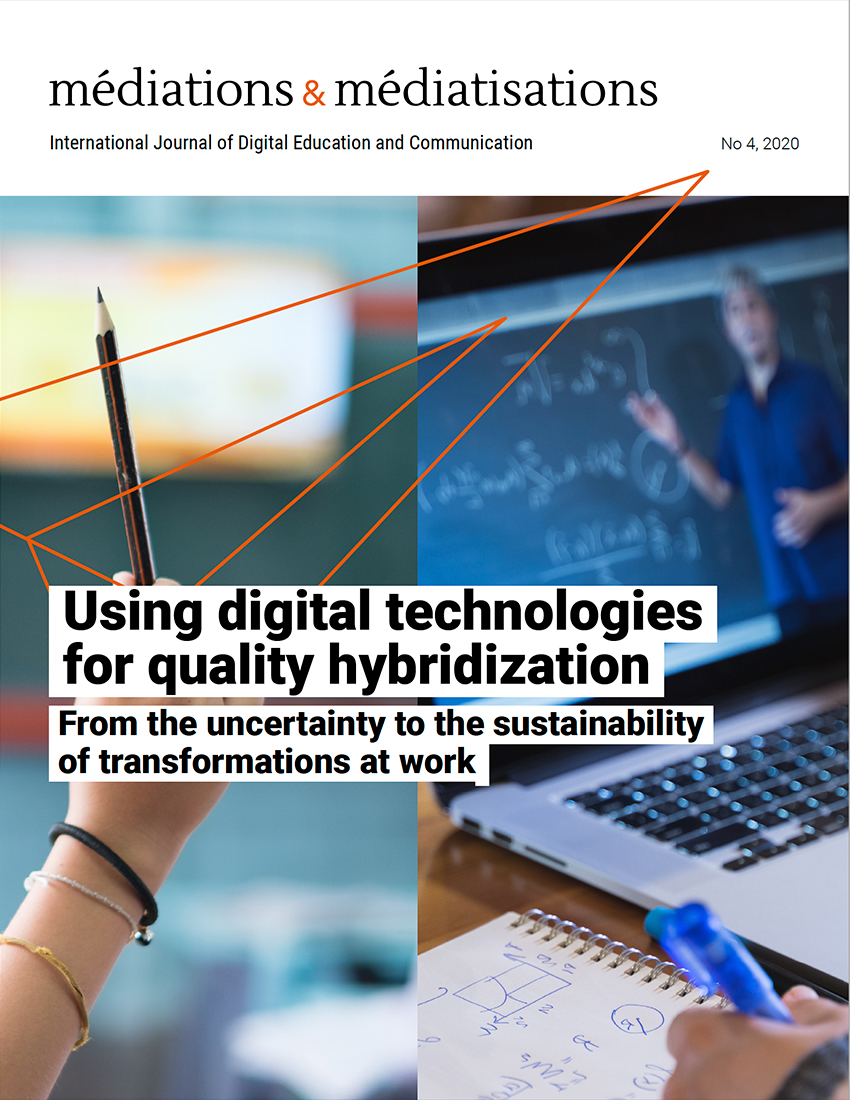Designing a classroom dedicated to teacher training in the 21st century: Reflections from an interdisciplinary project in a university context
Main Article Content
Abstract
The Classe du futur project aims to rethink classroom design in teacher training. This project is in line with the desire to offer flexible learning environments in university settings while preparing teachers for 21st-century challenges. In a concerted effort, design and education sciences students proposed a classroom planning design of existing space on the university's campus (UQAM). The result of those efforts is presented in this article. It also offers an occasion to reflect on the value of interdisciplinary research projects and classroom characteristics that enable active learning in university settings.
Downloads
Article Details

This work is licensed under a Creative Commons Attribution-NonCommercial-ShareAlike 4.0 International License.
References
Anderson, L. et Krathwohl, D. A. (2001). Taxonomy for Learning, Teaching and Assessing: A Revision of Bloom’s Taxonomy of Educational Objectives. Longman.
Barrett, P., Zhang, Y., Davies, F. et Barrett, L. (2015). Clever Classrooms: Summary Report of the HEAD Project. Université de Salford. https://usir.salford.ac.uk/id/eprint/35221/
Beaudoin, J. (2013). Introduction aux pratiques d’enseignement inclusives. Université d’Ottawa. https://www.uottawa.ca/respect/sites/www.uottawa.ca.respect/files/accessibilite-guide-inclusion-fr-2013-10-30.pdf
Bonwell, C. et Eison, J. A. (1991). Active Learning : Creating Excitement in the Classroom (ASHE-ERIC Higher Education Report No. 1). The George Washington University, School of Education and Human Development. https://files.eric.ed.gov/fulltext/ED336049.pdf
Céci, J. et Coudrin, D. (2014). (Re)penser les espaces physiques d'apprentissage. Fédération Interuniversitaire de l’Enseignement à Distance. https://doi.org/10.13140/RG.2.2.27110.11841
Chamberland, G., Lavoie, L. et Marquis, D. (1995). 20 formules pédagogiques. Presses de l’Université du Québec.
Cleveland, B. J. (2011). Engaging spaces: Innovative learning environements, pedagogies and student engagement in the middle years of school [Thèse de doctorat]. Université de Melbourne. https://pdfs.semanticscholar.org/e602/1e9e1df68311a7374a600c9ec3fb69a9b700.pdf
Collège LaSalle. (2020). Salles de classe actives. https://www.collegelasalle.com/a-propos/installations-specialisees/salles-de-classe-actives
Dede, C. (2010). Technological supports for acquiring 21st century skills. Dans E. Baker, B. McGraw et P. Peterson (dir.), International Encyclopedia of Education (3 éd., p. 158-166). Elsevier.
Delacourt, S. (2019). L'artiste-chercheur: Un rêve américain au prisme de Donal Judd. Éditions B42.
Ertmer, P. et Ottenbreit-Leftwich, A. (2013). Removing obstacles to the pedagogical changes required by Jonassen's vision of authentic technology-enabled learning. Computers & Education, 64, 1-8. https://doi.org/10.1016/j.compedu.2012.10.008
Ertmer, P., Ottenbreit-Leftwich, A. et Tondeur, J. (2015). Teachers’ beliefs and uses of technology to support 21st-century teaching and learning. Dans H. Fives et G. Michele (dir.), International handbook of research on teacher beliefs (p. 403-418). Routledge.
Fournier St-Laurent, S., Normand, L., Bernard, S. et Desrosiers, C. (2018). Les conditions d’efficacité des classes d’apprentissage actif. Collège Ahuntsic. https://eduq.info/xmlui/bitstream/handle/11515/35536/fournier-st-laurent-et-al-conditions-efficacite-classes-apprentissage-actif-parea-2018.pdf
Freeman, S., Eddy, S. L., McDonough, M., Smith, M. K., Okoroafor, N., Jordt, H. et Wenderoth, M. P. (2014). Active learning increases student performance in science, engineering, and mathematics. Proceedings of the National Academy of Sciences, 111(23), 8410-8415. https://doi.org/10.1073/pnas.1319030111
Global Partnership for Education (2020). 21st-Century Skills: What potential role for the Global Partnership for Education? A Landscape Review. GPE. https://www.globalpartnership.org/content/21st-century-skills-what-potential-role-global-partnership-education
Joynes, C., Rossignoli, S. et Amonoo-Kuofi, E. F. (2019). 21st Century Skills: evidence of issues in definition, demand and delivery for development contexts (K4D Helpdesk Report). Institute of Development Studies. https://assets.publishing.service.gov.uk/media/5d71187ce5274a097c07b985/21st_century.pdf
LearningLab Network. (2019). Les cahiers du Learning Lab Network. LearningLab Network. http://www.learninglab- network.com/wp-content/uploads/2019/06/Cahier_LLN_1.pdf
Lewin, C. et McNicol, S. (2015). Supporting the development of 21st century skills through ICT. In T. Brinda, N. Reynolds, R. Romeike et A. Schwill (dir.), KEYCIT 2014 : Key competencies in informatics and ICT (p. 98-181). University of Potsdam. https://publishup.uni-potsdam.de/opus4-ubp/frontdoor/deliver/index/docId/7032/file/cid07.pdf
McDaniel, S. (2014). Every Space is a Learning Space : Encouraging informal learning and collaboration in higher education environments. BWBR. https://www.bwbr.com/wp-content/uploads/2020/10/Every-Space-Is-A-Learning-Space_WP.pdf
McGill. (2020). Active Learning Classrooms (ALCs). https://www.mcgill.ca/tls/spaces/alc
Normand, L. (2017). L’apprentissage actif: une question de risques… calculés. Pédagogie collégiale, 31(1), 5-12. http://aqpc.qc.ca/sites/default/files/revue/normand-vol.31-1.pdf
Osguthorpe, R. T. et Graham, C. R. (2003). Blended learning environments : Definitions and directions. The Quarterly Review of Distance Education, 4(3), 227-233. https://www.learntechlib.org/p/97576/
Paquelin, D. (2017). Flexibilisation : principes et actions. Site du Bureau de soutien à l’enseignement de l’Université Laval. https://www.enseigner.ulaval.ca/sites/default/files/01-flexibilisation_mai_2017.pdf
Paquin, L. C. (2014). La recherche. Méthodologie de la recherche création. http://lcpaquin.com/metho_rech_creat/index.html
Prince, M. (2004). Does Active Learning Work? A Review of the Research. Journal of Engineering Education, 93(3), 1-9. https://doi.org/10.1002/j.2168-9830.2004.tb00809.x
Shishegar, N. et Boubekri, M. (2016, avril). Natural light and productivity: Analyzing the impacts of daylighting on students’ and workers’ health and alertness. Communication présentée à l’International Conference on “Health, Biological and Life Science”, Istanbul, Turquie. https://www.researchgate.net/publication/303484362_Natural_Light_and_Productivity_Analyzing_the_Impacts_of_ Daylighting_on_Students'_and_Workers'_Health_and_Alertness
Singh, H. (2003). Building effective blended learning programs. Educational Technology, 43(6), 51-54. http://asianvu.com/digital-library/elearning/blended-learning-by_Singh.pdf
Tondeur, J., Aesaert, K., Prestridge, S. et Consuegra, E. (2018). A multilevel analysis of what matters in the training of pre- service teacher's ICT competencies. Computers & Education, 122, 32-42. https://doi.org/10.1016/j.compedu.2018.03.002
Université Laval. (2013). Repenser les espaces physiques d’apprentissage : Orientations stratégies et pédagogiques.
Université Laval. https://www.enseigner.ulaval.ca/system/files/espaces_physiques-orientations_strategiques_0.pdf
Valdès, D. (1995). Vers de nouvelles formes de formations : Les formations hybrides (Mémoire de DESS, Université de Paris 2).

